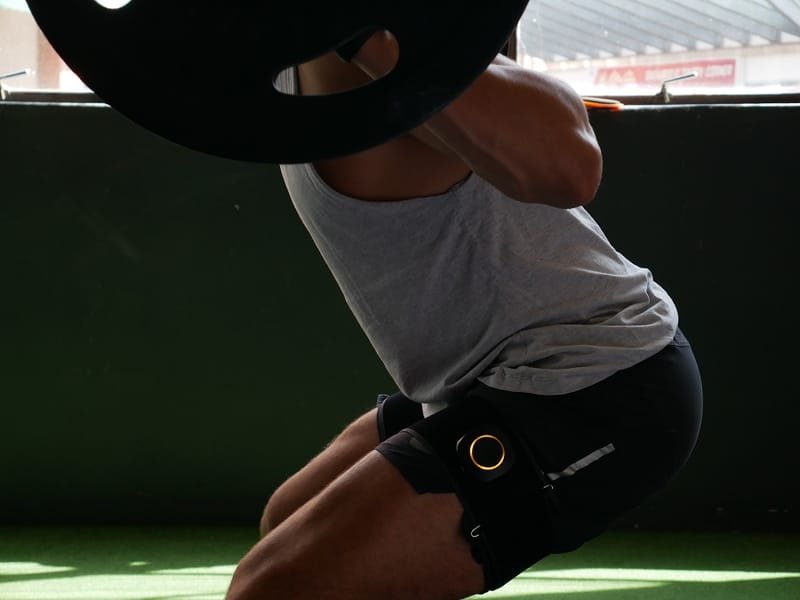IMPLICATIONS FOR ENHANCING RETURN TO PLAY – Written by Stephen D Patterson, UK, Johnny Owens, USA and Luke Hughes, UKINTRODUCTIONAnterior cruciate ligament (ACL) injury is one of the most prevalent musculoskeletal (MSK) conditions worldwide, totalling approximately 250,000 cases per year1. ACL injuries are common in both males and females, occurring at an average age of 30 years with an increasingly high annual incidence in all activity levels from recreational to professional sport2,3. While conservative treatment options exist, more often patients require ACL reconstruction (ACLR) surgery by means of allograft or autograft to restore the ligamentous structure, and thus anterior-posterior stability, of the knee joint4.The typical approach to ACLR rehabilitation has shifted from full limb immobilisation post-surgery to early restoration of range of movement (ROM) weight bearing and increased muscle activation5,6. However, even with more accelerated and aggressive rehabilitation a major consequence of ACL injury and subsequent reconstruction is significant thigh muscle atrophy7,8 and muscle weakness9 in the first weeks post-surgery10 and can persist for several years post operation11. There are many short-term12 and long-term13 consequences of ACLR such as decreased protein turnover14, strength loss9, arthrogenic inhibition15, an increased risk of osteoarthritis16 and reinjury17. The effects of muscle atrophy are unavoidable given the reduced weight bearing and unloading context of ACLR rehabilitation18 related to concerns of graft strain19, cartilage damage20, bone bruising and meniscal injury21, which often serve as contraindications to heavy load exercise to regain muscle strength and size. Additionally, muscle physiology appears to be altered after ACLR with signs of greater extracellular matrix and fewer satellite cells than prior to surgery22. Thus, clinicians are faced with the task of finding alternative rehabilitation tools.Blood flow restriction (BFR) is a novel training method that aims to partially restrict arterial inflow and fully restrict venous outflow in active musculature during exercise23. BFR training has been proposed as a tool for early rehabilitation post ACLR24,25 because of its low-load nature and hypertrophic capacity26. Our recent meta-analysis indicated that low-load BFR training is a safe and effective clinical rehabilitation tool when applied correctly27. BACKGROUND TO BFRSince its early emergence as a form of exercise training, restriction of blood flow is commonly referred to as ‘BFR training’28. This technique of restricting blood flow to the muscle using a pneumatic tourniquet system involves applying an external pressure, typically using a tourniquet cuff, to the most proximal aspect of the upper and / or lower limbs. When the cuff is inflated, there is compression of the vasculature underneath the cuff resulting in an ischemic environment, which subsequently results in hypoxia within the muscle29.Early research identified the capability of BFR to stimulate muscle hypertrophy and strength gains when combined with low-load resistance28. To date, the definitive mechanism(s) underpinning adaptations to low-load BFR training have not been pragmatically identified; however, proposed mechanisms include: cell swelling30 increased muscle fibre recruitment31 increased muscle protein synthesis32 and increased corticomotor excitability33. The low-load nature of BFR training and ability to create muscle hypertrophy and subsequent strength gains make it a powerful clinical rehabilitation tool; an alternative to heavy-load resistance training in populations that require muscle hypertrophy and strengths gains but in which heavy-loading of the musculoskeletal system is contraindicated 27,63.EFFECTIVENESS OF BFR IN THE EARLY STAGES OF REHABILITATIONRecently published research provides promising evidence of the effectiveness of BFR training in the early phases of rehabilitation post ACLR. In the UK National Health Service, we examined the effectiveness of BFR training compared to standard care rehabilitation in the first three months following ACL surgery7. Using a criteria-driven approach, patients began resistance training at approximately 21 days post-surgery. Using a leg press exercise, patients were randomised to either BFR training (4 sets (30, 15, 15, 15 reps) at 30% 1RM) or standard care heavy load training (3 sets (10, 10, 10 reps) at 70% 1RM), performing this twice per week for 8 weeks. Over 8 weeks of training, significant and comparable increases in muscle thickness (5.8 ± 0.2% and 6.7 ± 0.3%) and pennation angle (4.1 ± 0.3% and 3.4 ± 0.1%) were observed with BFR-RT and heavy load training respectively. Alongside this, significant and comparable increases in leg press strength were observed in the injured limb with BFR training (104 ± 30%) and heavy load training (106 ± 43%). Interestingly, BFR training appeared to attenuate knee extensor strength loss at fast speeds, possibly indicating a reduction in arthrogenic inhibition. In addition to muscle hypertrophy and strength adaptations, clinically meaningful improvements in several measures of physical function (International knee documentation committee score, lower extremity function scale, Lysholm knee-scoring scale and the Knee injury and osteoarthritis outcome score) were observed with BFR training, which were all significantly greater than heavy load training. This may be due in part to the greater reduction in knee pain and swelling found with subjects performing BFR training. Cumulatively, studies indicate that BFR training performed at a much lower exercise intensity improves physical function, pain and swelling to a greater extent than traditional resistance training, without any detrimental effect on muscle hypertrophy and strength adaptations. Using BFR training during rehabilitation post ACLR appears to be safe and practically feasible. No adverse effects on knee laxity have been found with BFR training compared to heavy load training7,34. It has also been shown both acutely and chronically that patients experience less knee pain during and for up to 24 hours post-exercise with BFR training35,36, with a greater overall reduction in pain following 8 weeks of training7,36. Moreover, the perceived exertion and muscle pain responses to BFR training appears not to limit application or adherence to training. Similar findings have been found in post-surgical BFR studies in the US military37. PHASES OF BFR USAGE FOLLOWING ACLRThe primary post-operative goals of ACLR are to reduce joint effusion, pain control and combat muscle atrophy and strength loss38. During this early phase (phase 1), unloading of the muscle causes muscle atrophy39,40; thus, passive BFR, which is the application of BFR without exercise, may be performed. Passive BFR creates an increase in cellular swelling that is evident after release of the cuff30, which may increase muscle protein synthesis and suppress breakdown41,42. Passive BFR can be applied using a protocol of 5 sets of 5 minutes full restriction followed by 3 minutes of rest and reperfusion to attenuate atrophy and strength loss of the quadriceps muscles25,43,44. In addition, voluntary isometric contractions during BFR may increase metabolic stress and cell swelling levels above passive BFR and contribute to muscle hypertrophy23,45, acting as a preparation phase to subsequent low-load BFR exercise. This first phase should begin a few days post-surgery provided that inflammation, pain and swelling is not excessive, and patients have passed a risk assessment questionnaire46. Neuromuscular electrical stimulation (NMES) combined with BFR has become more common in clinical practice in the acute phase of ACLR. Although this is a novel concept, studies combining low intensity NMES with BFR have found increases in muscle size and strength47,48. NMES of the quadriceps does not involve transmission of large forces through the tibiofemoral joint, thus exhibiting a low risk of damaging the graft or exacerbating any cartilage, meniscal, or bone injuries. Mitigating the loss of muscle strength and size in the acute stages of rehabilitation are necessary to perform voluntary training later in the rehabilitation process49. Thus, we are proposing NMES with BFR as an updated and potentially more effective approach to the early first postoperative phase.As range of motion is returned and gait is normalized, low-load resistance with BFR should be introduced to accelerate muscle hypertrophy and improve strength. A synthesis of the available literature indicates that low-load BFR training is an effective, tolerable and useful clinical MSK rehabilitation tool27. Low-load resistance training with BFR has been shown to increase muscle protein synthesis32 which may be a result of activation of the mTOR signalling pathway that is thought to be an important cellular mechanism for enhanced muscle protein synthesis with BFR exercise50. Such increases in muscle protein synthesis with low-loads can help recover and increase muscle size without loading the post-operative knee joint with heavy loads traditionally required for such adaptations. Low-load BFR resistance exercise may also be used to combat the reduced muscle satellite cell abundance observed during periods of unloading following ACLR51,52. Regarding strength, the early preferential recruitment of type II fast-twitch fibres at low-loads generated during BFR exercise is thought to be an important mechanism behind strength adaptations at such low loads. With BFR exercise, it appears that the normal size principle of muscle recruitment is reversed26. Fast-twitch fibres, which are more susceptible to atrophy and activation deficits during unloading53 are normally only recruited at high intensities of muscular work. During low-load resistance training with BFR it appears they are recruited earlier. Indeed, several studies have demonstrated increased muscle activation during low-load BFR resistance exercise54,55. Greater internal activation intensity has been found relative to external load during low-load BFR resistance exercise31, suggesting type II fibres are preferentially recruited. This preferential recruitment of the type II fibres that are more susceptible to atrophy during the early stages of ACL rehabilitation may help combat arthrogenic inhibition while also triggering muscle hypertrophy and recovery of strength HOW TO IMPLEMENT BFR TRAININGSo how do we go about using BFR in a practical setting? Recent research supports individualisation of BFR application, where BFR is prescribed as a percentage of ‘arterial limb occlusion pressure’ (LOP), which represents the minimum pressure required for total arterial occlusion23. Manipulation of BFR protocols has been shown to influence the perceptual, hemodynamic, and neuromuscular responses to BFR exercise. Therefore, a brief overview of the current consensus on BFR application during rest and exercise is provided in Table 1 & 256. HOW BFR CAN ENHANCE THE RETURN TO SPORT PROCESSWhen to return to sport following ACLR is a controversial issue. It is common for patients to be at a higher risk of re-injury compared to healthy controls57,58. Strength and conditioning coaches, rehabilitation specialists and surgeons utilize a range of assessments to determine an athlete’s readiness to return to sport, including: subjective rating scales, knee laxity testing, isokinetic testing, functional hop testing, balance testing, and movement assessment. Whilst this has improved over recent years, several studies have demonstrated deficits in muscular strength, kinaesthetic sense, balance, and force attenuation 6 months to 2 years following reconstruction58-60. With this in mind, the return to sport following ACLR should not be rushed. Furthermore, we suggest BFR be used to mitigate some of these residual deficits that athletes experience. By using BFR earlier in the rehabilitation to offset atrophy and strength loss (phase 1) and improve strength and hypertrophy (phase 2), practitioners can spend more time focussing on neuromuscular control, functional strength, rate of force development, and psychological readiness which are necessary for a successful return to competition and reducing the risk of re-injuryCONCLUSION / FUTURE WORKBFR provides a low-load safe and efficacious treatment modality for athletes following ACLR. As it gains more acceptance in clinical settings and more robust clinical trials are published, there has been a shift in the acuity of its usage and adoption across clinical conditions. Clinical trials have advanced to not just explore the ability of BFR to preserve and restore lost muscle mass and strength, data are now available which report its ability to preserve bone loss after ACLR61, provide a reduction in pain, swelling and function7,36.More recent advancements have also advocated its use in prehabilitation prior to ACLR62 where a reduction of muscle fibrosis and upregulation of satellite cells have been shown along with accelerated return to play. Thus, we propose that these findings provide an important message for clinicians and athletes alike - train hard, train smart and start early! Stephen D Patterson Ph.D.Reader in Applied Exercise Physiology and PerformanceSt Marys University, Faculty of sport, Health & Applied science,London, United KingdomJohnny Owens MPTChief of Human Performance OptimzationOwens Recovery Systems, San Antonio, Texas, USALuke Hughes Ph.D.Post-doctoral research fellow in Applied PhysiologySt Marys University, Faculty of sport, Health & Applied science,London, United Kingdom



